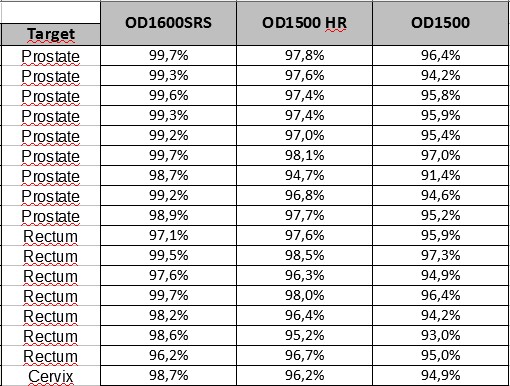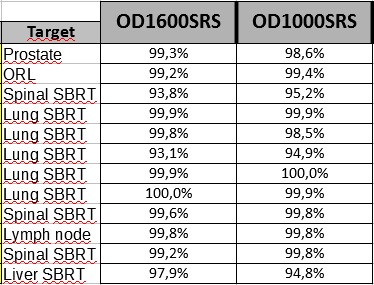Patient QA comparison between three different OCTAVIUS 4D arrays in radiotherapy treatments
Tamara Lusa Aguero,
Spain
PO-1794
Abstract
Patient QA comparison between three different OCTAVIUS 4D arrays in radiotherapy treatments
Authors: Constantino Velasco Fernandez1, Iago Mosquera Cereijo2, Tamara Lusa Agüero2, Roberto Gómez Pardos2, Jorge Bonaque Alandi3
1Hospital Clinico Universitario de Valencia, Medical Physics and radiological protection, Valencia, Spain; 2Hospital Clinico Universitario de Valencia, Medical Physics and radiological protection , Valencia, Spain; 3Consorcio Hospitalario Provincial de Castellón, Medical Physics and radiological protection , Castellón, Spain
Show Affiliations
Hide Affiliations
Purpose or Objective
Detector arrays are widely used for patient QA and there are several available models for that purpose. The aim of this study is to compare and analyze gamma-criteria results of different QA plans for three PTW extended used arrays.
Material and Methods
Three PTW arrays has been used: OCTAVIUS Detector 1600 SRS (OD1600SRS), OCTAVIUS Detector 1500 (OD1500) and OCTAVIUS Detector 1000 SRS (OD1000SRS).
OD1500 has 1405 plane-parallel vented ionization chambers of 0.06 cm³ and a maximum field of 27 cm x 27 cm. OD1000SRS and OD1600SRS have 977 and 1521 liquid-filled ionization chambers of 0.003 cm³ and a maximum field of 11 cm x 11 cm and 15 cm x 15 cm, respectively.
The OD1500 is used for plans that require a relative large area of measurement and its spatial resolution is the lowest of the three detectors analyzed.
OD1000SRS has a smaller active area, but its spatial resolution is higher than OD1500. It is used for small volumes, typically the ones destined to be treated with SRS/SBRT techniques.
The last available model, OD1600SRS, is built to be an improved mix of the two above in terms of spatial resolution.
Several patient QA plans has been measured with the OD1500, OD1600SRS and OD1000SRS using an Elekta Versa HD.
These patient QA plans are divided in two categories: relatively large target volumes (mainly prostates and rectums) measured with OD1600SRS, OD1500 and merging two measurements with an offset of 5 mm between them in G-T direction, in order to improve the spatial resolution of this array (that we name OD1500 HR); and smaller volumes measured using OD1000 and OD1600SRS.
Results
The results of the gamma analysis has been compared between them and summarized in Table 1 and Table 2. It has been applied a Global 2%/2mm criteria with a threshold of 10% of the maximum dose.
Table 1: OD1600SRS vs OD1500HR and OD1500

After applying a Student’s t-test we can confirm with a 95% confidence interval that there are significant differences between the results obtained with OD1600SRS and OD1500 (in favour of the first one), even using double measurement to improve spatial resolution of OD1500:
• OD1600SRS vs OD1500HR: p-value = 4.44·10^(-6)
• OD1600SRS vs OD1500: p-value = 1.57·10^(-8)
Table 2: OD1600SRS vs OD1000SRS

Nevertheless, no significant differences can be found between OD1600SRS and OD1000SRS:
• OD1600SRS vs OD1000SRS: p-value = 0.42
Conclusion
Differences in gamma results up to 7.3% has been found between OD1500 and OD1600SRS, in favour of OD1600SRS, but we see no significant deviations between the results obtained with OD1600SRS and OD1000SRS in small VMAT volumes.
On the other hand, OD1600SRS achieves significant better results than OD1500 even with double resolution (OD1500 HR)
We conclude that, for patient QA procedure in relatively large and smaller target volumes, OD1600SRS yields the best results regardless of the volumes to be measured.